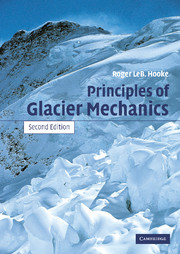Book contents
- Frontmatter
- Contents
- Preface to the first edition
- Preface to the second edition
- Physical constants relevant to ice
- Derived SI units and conversion factors
- 1 Why study glaciers?
- 2 Some basic concepts
- 3 Mass balance
- 4 Flow and fracture of a crystalline material
- 5 The velocity field in a glacier
- 6 Temperature distribution in polar ice sheets
- 7 The coupling between a glacier and its bed
- 8 Water flow in and under glaciers: geomorphic implications
- 9 Stress and deformation
- 10 Stress and velocity distribution in an idealized glacier
- 11 Numerical modeling
- 12 Applications of stress and deformation principles to classical problems
- 13 Finite strain and the origin of foliation
- 14 Response of glaciers to changes in mass balance
- Appendix: Problems
- References
- Index
3 - Mass balance
Published online by Cambridge University Press: 24 November 2009
- Frontmatter
- Contents
- Preface to the first edition
- Preface to the second edition
- Physical constants relevant to ice
- Derived SI units and conversion factors
- 1 Why study glaciers?
- 2 Some basic concepts
- 3 Mass balance
- 4 Flow and fracture of a crystalline material
- 5 The velocity field in a glacier
- 6 Temperature distribution in polar ice sheets
- 7 The coupling between a glacier and its bed
- 8 Water flow in and under glaciers: geomorphic implications
- 9 Stress and deformation
- 10 Stress and velocity distribution in an idealized glacier
- 11 Numerical modeling
- 12 Applications of stress and deformation principles to classical problems
- 13 Finite strain and the origin of foliation
- 14 Response of glaciers to changes in mass balance
- Appendix: Problems
- References
- Index
Summary
Glaciers exist because there are areas, generally at high elevations or in polar latitudes, where snow fall during the winter exceeds melt (and other losses) during the summer. This results in net accumulation, and this part of the glacier is thus called the accumulation area (Figure 3.1). As each snow layer is buried, the pressure of the overlying snow causes compaction, and movement of molecules in the liquid and vapor phases results in snow metamorphism. Snow that is more than a year old, and has thus been altered by these processes, is called firn. The end result of the firnification process, normally after several years, is solid ice.
Where there are lower elevations to which this ice can move, gravitational forces drive it toward these areas. This eventually brings the ice into places where the annual melt exceeds snow fall. Here, all of the winter snow and some of the underlying ice melts during the summer. This is called the ablation area. The line separating the accumulation and the ablation areas at the end of a melt season is called the equilibrium line. Along the equilibrium line, melt during the just-completed summer exactly equaled net snow accumulation during the previous winter.
In this chapter, we first discuss the transformation of snow to ice, and show how the processes involved result in a physical and chemical stratigraphy that, under the right circumstances, can be used to date ice that is thousands of years old.
- Type
- Chapter
- Information
- Principles of Glacier Mechanics , pp. 17 - 42Publisher: Cambridge University PressPrint publication year: 2005



